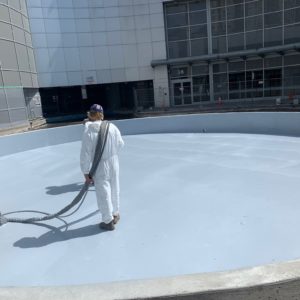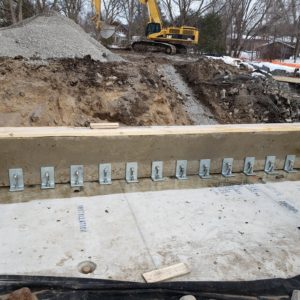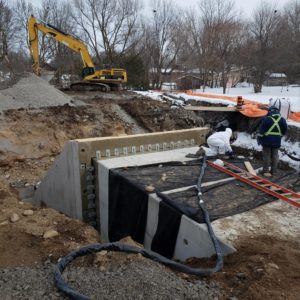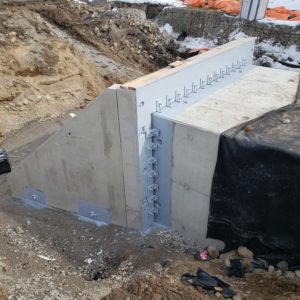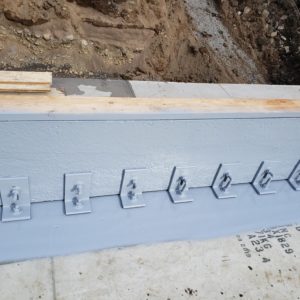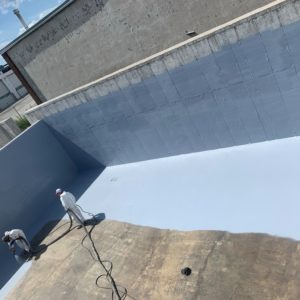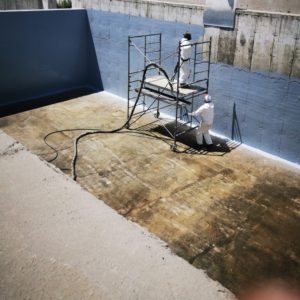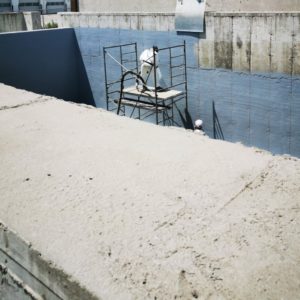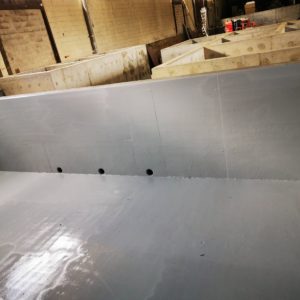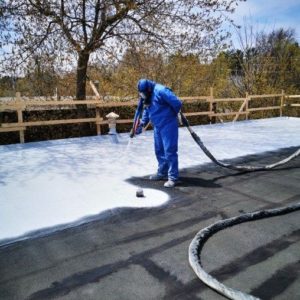- Polyurea – Waterproofing for Basements, Tanks, Foundations, Tunnels
- ISOMAT CEMENTITIOUS BASED COATING SYSTEMS FOR WATERPROOFING IN CANADA
- ISOMAT WATERPROOFING MEMBRANES AND MASTICS IN CANADA
- Waterproofing of Walls – Sealers, Elastomeric Coatings – Nano Technology
- ISOMAT WATERPROOFING MATERIALS FOR JOINTS IN CANADA
- Compelementary Waterproofing Products – Reinforcements
As an organization ISOMAT strives to provide the latest product advancements and the most efficient methods of installation. ISOMAT Polyurea Coatings reduce costs from both an energy efficiency and maintenance standpoint. From an installation perspective labour and time is also greatly reduced.
These coatings will not require replacement for a minimum of 30 years and are cutting edge environmentally friendly technology. They are excellent for use as a protective and waterproof coating in infrastructure/construction projects whether it is new construction or rehabilitation of existing structures.
Wastewater Infrastructure
In municipalities many of the existing wastewater systems are deteriorating, at the same time population demands are pressing upon cities to expand their wastewater collection capabilities. More and more municipalities are addressing this growing health and environmental challenge by paying increased attention to rehabilitating corroded manholes. By most industry estimates, leaking manholes account for an estimated 20% – 30% of the unnecessary groundwater infiltration and inflow that overtax and threaten the sanitary sewage system.
Advanced, high-performance polyurea coatings are increasingly finding a place in manhole rehabilitation due to their corrosion resistance and long-term effectiveness. Featuring higher film builds, faster dry times and other advantages, these new protective coating formulations offer cost-effective solutions to municipalities seeking to reduce downtime, restore access and minimize the costs associated with sewer system repair.
A primary cause of corrosion in municipal sewer environments is MIC or Microbiologically Induced Corrosion. MIC occurs when bacteria of the genus Thiobacillus, “concrete-eating bacteria,” oxidize sulfur from hydrogen sulfide, “sewer gas,” and produce sulfuric acid as a by-product. Sulfuric acid is highly corrosive to concrete, steel and non-ferrous metals. When concentrated and heated by summer temperatures, it is extremely damaging to the concrete and non-ferrous metals used in most wastewater structures. Construction materials in such environments quickly lose their ability to support loads, maintain their shape, transport liquids and function as designed. Manholes may be among the toughest environments encountered.
For many years, manhole rehabilitation consisted mainly of spot repair or patching, typically offering only a temporary solution to the inevitable acid attack. Today’s cementitious coatings are more sulfide-resistant, yet they still remain vulnerable to the corrosion that eroded the cement in the first place. Structural form repair using PVC liners with mechanical locking projections cast into the concrete provides an effective level of protection; however, installation generally requires excavating the manhole or replacing the entire structure and building a new one.
Many municipalities have discovered that high-performance polyurea coating systems offer the easiest and most effective way to rehabilitate manholes without having to excavate. These corrosion control coatings form a protective layer between the substrate and the chemical attackers — essentially prohibiting the environment from reaching the concrete. In the absence of major structural damage, advanced corrosion-resistant systems can offer 50 to 100 years of service life with proper maintenance.
These coatings are also suitable for other wastewater treatment facilities where hydrogen sulfide concentrations frequently can occur such as wet wells, lift stations, dewatering buildings and odor control buildings. When coated with polyurea, concrete and steel substrates can be submerged, buried or driven upon in just minutes. This fast reaction time is particularly appealing in municipal wastewater rehabilitation because it permits quick installation and a nearly immediate return to service.
Piping
Waste, discharge, and potable water and chemical lines are coated for exterior protection when being installed and interior protection for rehabilitation underground. Steel/metal pipes and pipelines increasingly use polyurea to protect from corrosion. Polyurea technology outperforms other coatings in nearly every measurable way. Therefore, facility owners enjoy reduced maintenance services and costs.
Tunnels
Tunnels sprayed with polyurea are less susceptible to moisture and gas vapor ingress.
Bridges
In the world of concrete bridge protection, liquid-applied high-performance polyurea membranes have continued to grow as the material of choice over the past 15 years. Polyurea’s enhanced durability, bonding to concrete and crack-bridging characteristics are unmatched by other coatings and paints that have been used historically.
State-of-the-art waterproofing membranes of polyurea serve to divert water and in northern climes deicing salts away from the bridge support structure. Polyurea coatings can prevent the collapse of concrete structures by effectively repairing a deteriorating portion of the concrete structure and by providing a protective seal around cracking and deteriorating concrete. Polyurea’s ability to fight off corrosion and outlast paint is a major reason these systems are being specified for bridge deck and structure coating. The most common applications of polyurea coatings on bridges are over steel and concrete.
Secondary Containment
An asset that can leak and discharge content can have polyurea spray coated to protect the environment. Exposed polyurea is widely used in applications such as concrete or geotextile coatings for secondary containment applications. Polyureas’ fast cure times allow it to be rapidly applied to a prepared substrate with minimal downtime for the facility. This has made polyurea the choice of facility managers for walls around and floors under chemical storage of diluted acids, alkali, salt solution, organic solvents and oils. Polyurea provides a strong barrier to spills from reaching the environment. In this type of application, polyurea readily conforms to footings, pipes and protrusions to form a complete seal. An aliphatic polyurethane topcoat can be added for aesthetics in environments where this would be required.
Secondary Containment – Airport Fuel Vaults
Fuel vaults sealed by polyurethane to fill gaps and then polyurea to provide a complete seal prevent soil and water table contamination.
Secondary Containment – Aviation Fueling and Deicing
Deicing fluid and potential spill collection pads and basins that are effective in containment when coated by polyurea spray coating.
Tank Coatings
Polyurea is great for extending the life of older tanks or can be applied during primary construction. Polyurea minimizes downtime compared to most materials with its rapid cure time, making it ideal for retrofit.
Tank Linings
Polyurea linings are resistant to many chemicals and industrial liquids. With its fast application advantages and ability to adhere to properly prepared substrates, polyurea is ideal for new storage tank primary lining and rehabilitation projects.
Flooring and Parking Decks
Polyurea flooring systems are most popular for their rapid turnaround installation capabilities. Parking decks have a constant stream of heavy vehicles passing through with the average passenger vehicle weighing approximately 4,000 pounds. These parking decks are constantly exposed to heavy loads, mechanical abrasion (tire friction), chemicals (sitting cars may leak fluids or oil), road salt tracked in on winter tires etc. Polyurea have the durability and chemical resistance for use in areas of high traffic.
Aquarium Lining
Aquariums have found major benefits with polyurea linings. The ability to form to properly prepared, custom-shaped walls and themed ornaments make this system very desirable. A spray-applied, water-resistant liner, available in a variety of colors with rapid return-to-service installation is why aquarium facility owners are turning to Polyurea.
Protection of Rail Cars and Containers
The area in and around rail cars is one of the most unforgiving places for any coating. Iron and steel impacting each other can quickly turn a seamless epoxy coating to dust and start the cycle of corrosion. Also the constant loading and unloading of cars filled with coal, lumber, steel and grain creates a highly abrasive environment that only the toughest coatings can withstand. Liquid containment railcars use polyurea for its waterproofing and chemical resistance benefits.
In highly abrasive situations, elastomeric polyureas are outperforming traditional coatings in physical properties and economics. As the cost of repairing and maintaining rail cars continue to rise, rail car owners and transit authorities are turning to high performance protective coatings to keep their rail cars in operation as long as possible.
Marine
Above the water line and below, Polyurea can be very effective in protecting steel, aluminum, and fiberglass in a variety of water sport and commercial marine applications.
Water Parks and Playgrounds
Molded slides, protective coating of seats for wet/dry amusement rides, tank linings, water containment, aquariums, and concrete stadium seats are just a few of the many applications polyurea is commonly used for in the amusement and theme park industry.
Landscape and Water Containment
Many projects use polyurea to contain water for ponds and pool decorations to form a primary containment liner.
